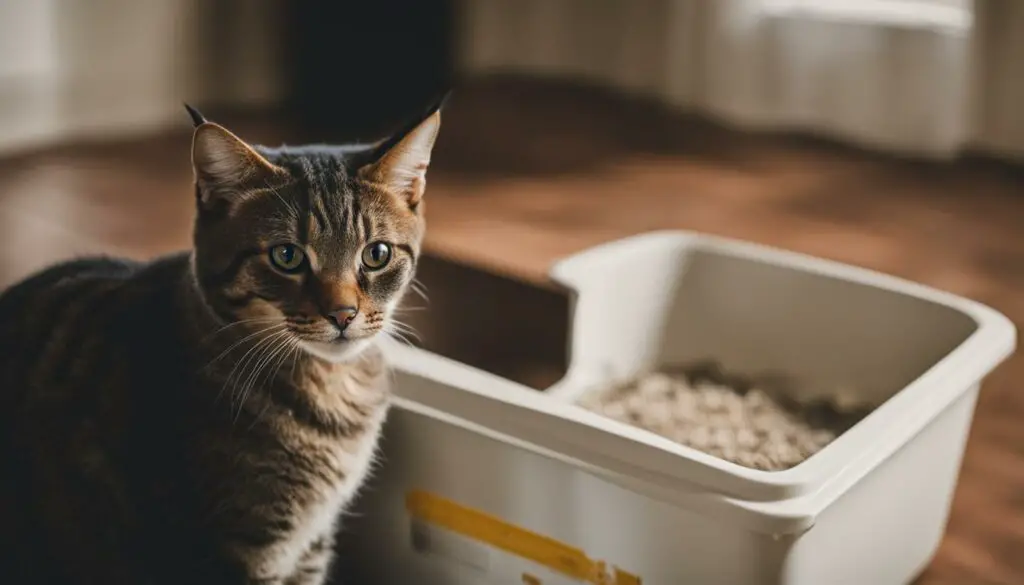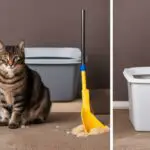Are you facing the frustrating problem of finding your beloved cat’s poop outside the litter box? Don’t worry, you’re not alone. Many cat owners encounter this issue, and there are several reasons why it may be happening. In this article, I will guide you through the troubleshooting process to help you understand why your cat is pooping next to the litter box and how to resolve this problem.
Key Takeaways:
- There can be various reasons why a cat poops next to the litter box, including health issues, stress, litter box problems, and changes in the household.
- Consulting a veterinarian is crucial to rule out any underlying health problems and seek appropriate treatment.
- Behavioral factors such as stress and anxiety can also contribute to litter box problems, and identifying and addressing these factors is essential.
- Keeping the litter box clean, providing a quiet and private location, and using a litter type that your cat prefers can encourage proper litter box usage.
- Creating a stress-free environment for your cat, maintaining a consistent routine, and using stress reduction techniques can help alleviate litter box issues.
Possible Health Issues
When a cat starts pooping outside the litter box, it could be indicative of underlying health issues. Cats may experience various medical conditions that can affect their bowel movements and cause them to avoid the litter box. These health problems can range from constipation and diarrhea to urinary tract infections and gastrointestinal issues.
Constipation, for example, can make it uncomfortable for cats to defecate, leading them to find alternative spots. On the other hand, cats with diarrhea may associate the litter box with pain or discomfort and seek other places to relieve themselves. Furthermore, urinary tract infections and gastrointestinal issues can also contribute to litter box avoidance behavior.
If your cat is consistently pooping outside the litter box, it is essential to consult a veterinarian. They will be able to conduct a thorough examination and possibly run tests to identify any underlying health problems. Once these issues are addressed and properly treated, your cat’s litter box behavior may improve.

Possible Health Issues
| Health Condition | Symptoms | Treatment |
|---|---|---|
| Constipation | Straining to defecate, small or no bowel movements | Dietary changes, laxatives, increased water intake |
| Diarrhea | Soft or watery stools, urgency to defecate | Dietary adjustments, probiotics, medication if necessary |
| Urinary Tract Infections | Frequent urination, blood in urine, discomfort during urination | Antibiotics, increased water intake, dietary changes |
| Gastrointestinal Issues | Vomiting, decreased appetite, weight loss | Dietary modifications, medication, possible surgery |
It is important to note that while health issues can contribute to litter box avoidance, they are not the only potential cause. Behavioral factors, litter box issues, and environmental stressors are also significant factors to consider when troubleshooting this problem.
By addressing any possible health issues and seeking appropriate treatment, you can help improve your cat’s overall well-being and potentially resolve the litter box avoidance behavior.
Behavioral Factors
When it comes to solving litter box issues, it’s important to consider the behavioral factors that may be causing your cat to poop outside the litter box. Cats are sensitive creatures, and changes in their environment or routine can lead to stress, which in turn can result in litter box problems.
One common behavioral factor is relocation. Moving to a new home can be stressful for cats, and they may struggle to adjust to the new litter box location. Similarly, the introduction of new pets or loud noises in the household can cause anxiety for your cat, leading to litter box aversion. Changes in the cleanliness of the litter box, such as a dirty or smelly box, can also discourage cats from using it.
To address these behavioral factors, it’s important to identify and eliminate any stressors in your cat’s environment. Settling your cat into a calm and predictable routine can help reduce anxiety. Providing hiding spots or safe spaces for your cat to retreat to can also help alleviate stress. Additionally, using pheromone sprays or diffusers can create a sense of comfort and security for your cat.
Creating a Calm Environment
Creating a calm environment for your cat is crucial in resolving litter box problems. In addition to reducing stressors, providing environmental enrichment can help keep your cat mentally stimulated and content. Interactive toys, scratching posts, and puzzle feeders can help alleviate boredom and provide an outlet for your cat’s natural instincts.
Furthermore, maintaining a consistent litter box routine is essential. Regularly scooping the litter box and ensuring it is clean and odor-free can encourage your cat to use it. Finding the litter type that your cat prefers is also important. Some cats may have specific preferences for litter texture or scent, so experimenting with different options can help determine which litter your cat is most comfortable with.
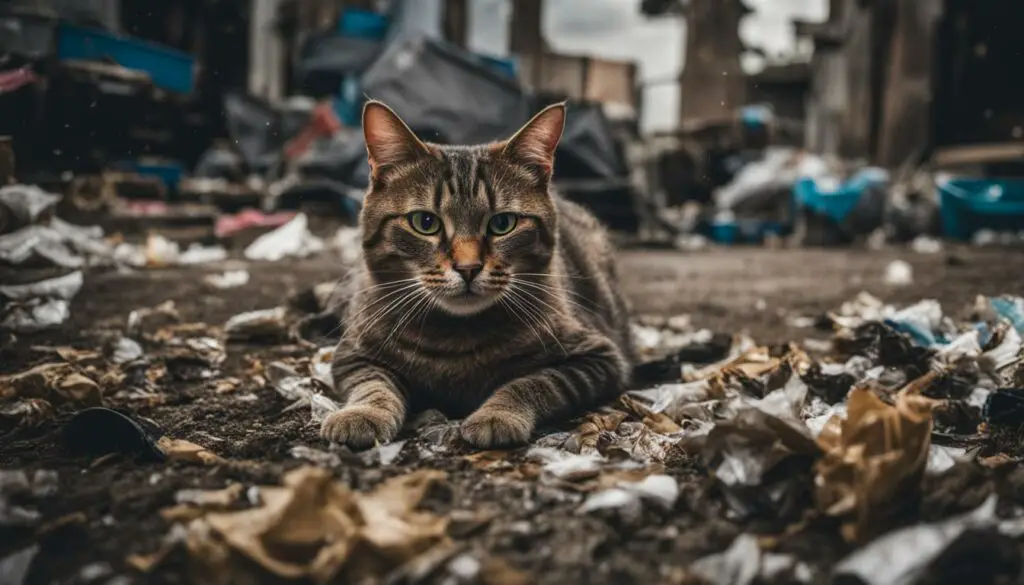
Summary
Behavioral factors play a significant role in a cat’s litter box habits. Identifying and addressing stressors, providing a calm environment, and maintaining a consistent litter box routine can help resolve litter box problems caused by behavioral issues. By understanding your cat’s needs and preferences, you can create a positive and stress-free environment that promotes proper litter box usage.
Litter Box Issues
When it comes to litter box problems, several factors related to the litter box itself can contribute to a cat pooping outside the box. Addressing these issues can help encourage proper litter box usage and reduce accidents.
Litter Box Cleanliness
Cats are naturally clean animals, and a dirty litter box can be a major deterrent. Regularly scooping out clumps and feces from the litter box is important to maintain cleanliness. Aim to scoop at least once or twice a day, depending on the number of cats using the box. Additionally, deep cleaning the litter box with mild soap and water on a weekly basis helps remove any lingering odors that may bother your cat.
Litter Box Location
The location of the litter box also plays a crucial role in a cat’s willingness to use it. Cats prefer privacy when using the litter box, so it’s essential to place it in a quiet and easily accessible area where they won’t be disturbed. Avoid placing the litter box near loud appliances, busy walkways, or areas where the cat’s food and water bowls are located. Providing a calm and secluded spot can help your cat feel comfortable while using the litter box.
Litter Box Size
The size of the litter box is another important consideration. Cats need enough space to comfortably maneuver and dig in the litter. If the litter box is too small, your cat may feel cramped and choose to eliminate outside the box. Consider providing a larger litter box, especially if you have a larger breed of cat. Providing ample space can encourage your cat to use the litter box appropriately.
| Litter Box Issues | Solutions |
|---|---|
| Litter Box Cleanliness | – Regularly scoop clumps and feces – Deep clean with mild soap and water |
| Litter Box Location | – Choose a quiet and accessible area – Avoid placing near loud appliances or food bowls |
| Litter Box Size | – Provide a larger litter box for bigger cats |
By ensuring a clean litter box, choosing an appropriate location, and providing a suitable size, you can address common litter box issues and create an environment that encourages proper litter box usage for your cat.
Cleaning and Maintaining the Litter Box
Proper cleaning and maintenance of the litter box are crucial for ensuring your cat’s comfort and promoting good litter box habits. By following a few simple steps, you can create a clean and inviting environment for your feline friend.
Regularly scooping clumps from the litter box is essential to keep it clean and odor-free. Cats are known for their cleanliness, and a dirty litter box can be a major deterrent for them. Aim to scoop at least once a day to remove any solid waste and clumps, and dispose of them in a sealed bag.
Deep cleaning the litter box on a regular basis is also important. Empty the litter box completely and wash it with warm water and unscented soap to remove any residue. Rinse thoroughly and dry the box before refilling it with clean litter. It is recommended to deep clean the litter box at least once a month to maintain hygiene.
Using unscented litter is preferable as cats have a highly sensitive sense of smell. Strong scents can be overwhelming for them and may discourage litter box usage. Additionally, using gloves and a face mask during the cleaning process is recommended to protect yourself from potential bacteria or parasites present in cat feces.
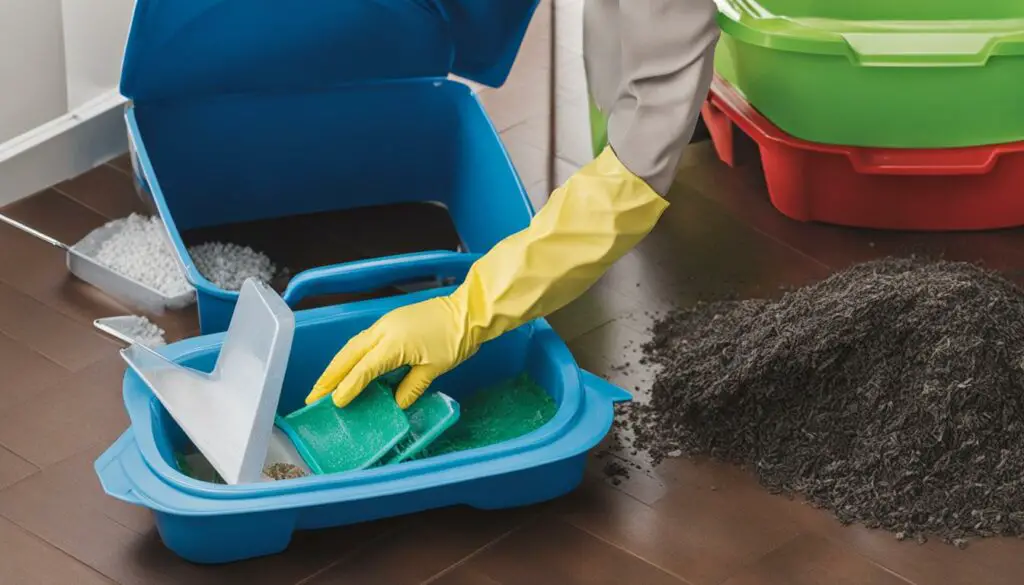
Table: Comparison of Litter Box Cleaning Methods
| Cleaning Method | Frequency | Effectiveness | Advantages |
|---|---|---|---|
| Daily Scooping | Once a day | Highly effective | Prevents odor buildup, reduces the likelihood of accidents |
| Deep Cleaning | Monthly | Highly effective | Ensures thorough hygiene, eliminates bacteria |
| Use of Unscented Litter | Ongoing | Highly effective | Avoids overwhelming scents, cat-friendly |
By following these cleaning and maintenance practices, you can ensure that your cat has a clean and comfortable litter box. A clean litter box not only promotes good litter box habits but also helps maintain your cat’s health and well-being.
Number and Placement of Litter Boxes
In multi-cat households, ensuring that there are enough litter boxes is crucial for maintaining harmony and preventing litter box issues. As a general rule, there should be one more litter box than the number of cats in the house. This means that if you have two cats, you should provide three litter boxes. Having multiple litter boxes allows each cat to have their own designated space and reduces the likelihood of conflicts over territory.
When it comes to litter box placement, it is important to choose quiet and easily accessible areas. Cats prefer privacy when they use the litter box, so avoid placing them in high-traffic areas or next to loud appliances. It’s also essential to keep the litter box away from the cat’s food and sleeping areas, as cats have a natural instinct to keep these areas separate.
To summarize, providing multiple litter boxes and placing them in suitable locations helps ensure that each cat has access to a clean and private space to do their business. This not only promotes better litter box habits but also helps prevent territorial conflicts among cats.
| Benefits of Multiple Litter Boxes | Benefits of Proper Placement |
|---|---|
|
|
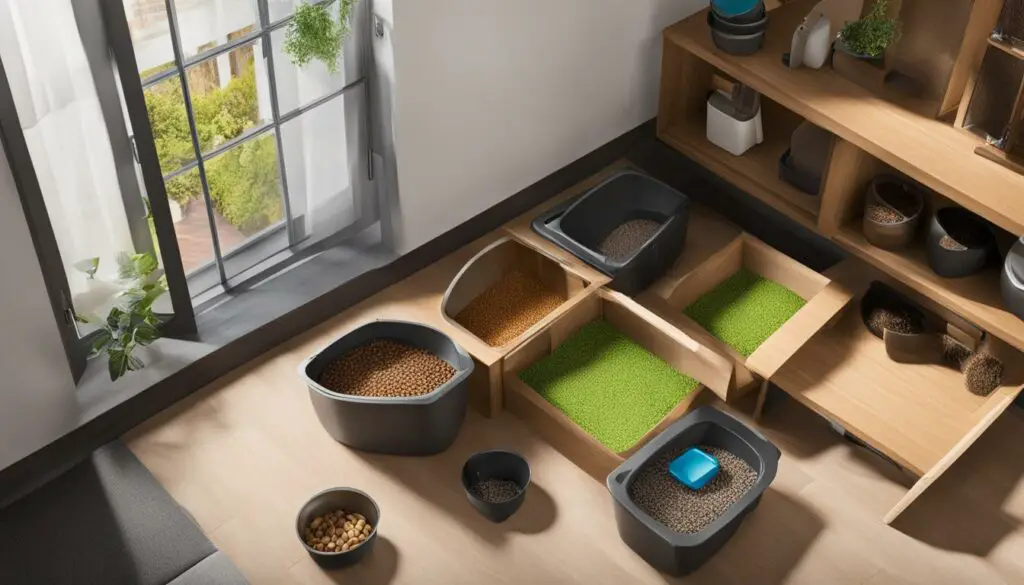
In conclusion, by considering the number and placement of litter boxes, you can create a comfortable and stress-free environment for your cats. Remember to provide one additional litter box for each cat and choose quiet, easily accessible locations for placement. These simple adjustments can go a long way in preventing litter box issues and promoting good litter box habits in your feline companions.
Cat Litter Preferences and Changes
Cats can be quite particular when it comes to their litter box and the type of litter they prefer. Understanding your cat’s litter preferences and making appropriate changes can help prevent litter box aversion and encourage proper usage. Here are some key factors to consider:
Litter Texture and Scent
Cats may have specific preferences for the texture and scent of their litter. Some cats prefer fine, sandy textures, while others may prefer a coarser texture. Similarly, cats may have individual preferences for scented or unscented litter. It is essential to observe your cat’s behavior and reactions to different types of litter to determine their preferences. Stick to a litter that your cat finds comfortable and pleasing to maximize litter box usage.
Gradual Litter Changes
If you need to change your cat’s litter for any reason, it is crucial to do so gradually. Abrupt changes in litter type can confuse and upset cats, leading to litter box aversion. Start by mixing a small amount of the new litter with their current litter and gradually increase the ratio over a week or two, allowing your cat to acclimate to the new litter gradually. This gradual transition can help prevent any negative associations with the litter box and ensure a smooth transition.
To summarize, understanding your cat’s litter preferences and making gradual changes when necessary can help maintain litter box usage and prevent aversion. Pay attention to the texture and scent your cat prefers and provide a litter that meets their preferences. If a change in litter is necessary, transition gradually to prevent any negative associations. By catering to your cat’s preferences, you can create a comfortable and inviting litter box environment for them.
Stress Reduction Techniques
Creating a calm and stress-free environment for your cat is essential in resolving litter box problems. Cats are sensitive creatures, and various factors can contribute to their stress levels. By implementing these stress reduction techniques, you can help alleviate your cat’s anxiety and promote proper litter box usage.
1. Maintain a Consistent Routine
Cats thrive on routine and familiar surroundings. Stick to a regular schedule for feeding, playtime, and litter box cleaning. Consistency helps reduce stress and provides a sense of security for your cat.
2. Provide Hiding Spots and Safe Spaces
Cats need a space where they can retreat and feel safe. Create hiding spots in your home by offering cozy beds, cat trees, or cardboard boxes with blankets. Providing vertical spaces allows cats to observe their surroundings and escape from potential stressors.
3. Use Pheromone Sprays
Pheromone sprays, such as Feliway, can help create a calming atmosphere for cats. These synthetic pheromones mimic natural cat pheromones, which can help reduce stress and behavioral issues. Spray Feliway in areas where your cat spends most of its time.
4. Introduce Interactive Toys and Scratching Posts
Engaging your cat in interactive play helps reduce stress and provides mental stimulation. Use toys that encourage hunting and pouncing behaviors. Additionally, provide scratching posts to fulfill your cat’s natural instinct to scratch and mark territory.
By implementing these stress reduction techniques, you can create a calm and inviting environment for your cat. Remember to be patient and observe your cat’s behavior for any signs of improvement. If the litter box problem persists, it is advisable to consult a veterinarian for further guidance and support.
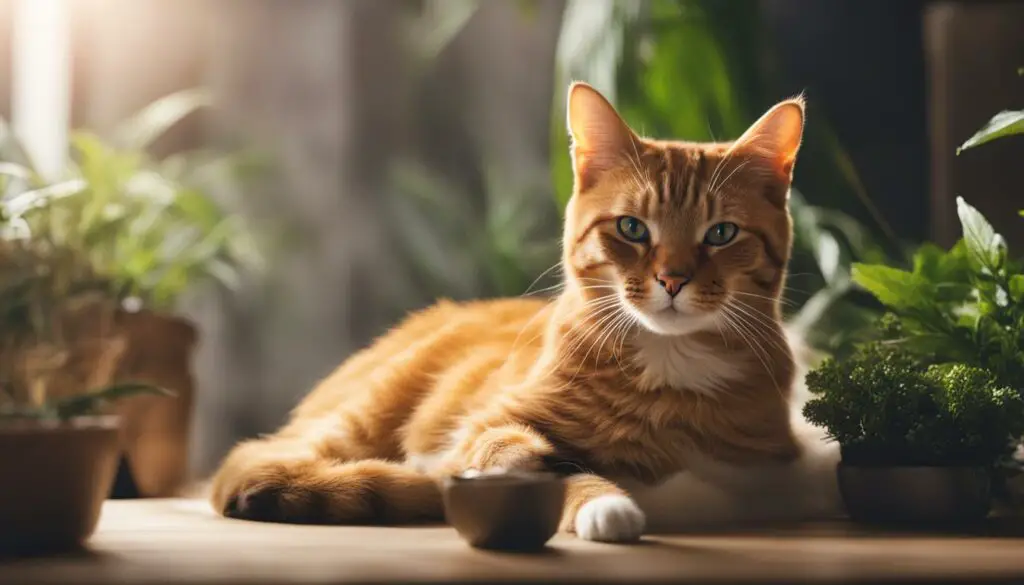
Elderly Cat Considerations
Elderly cats require special attention and accommodations, especially when it comes to their litter box needs. As cats age, they may experience joint pain, arthritis, or mobility issues, making it difficult for them to access and use a standard litter box. To ensure their comfort and well-being, there are a few considerations to keep in mind.
Litter Box Accessibility
One of the most important aspects of accommodating an elderly cat is ensuring that the litter box is easily accessible. This means providing a litter box with low sides to facilitate easy entry and exit. Additionally, placing the litter box on a non-skid mat can prevent slips and falls, which are common concerns for cats with reduced mobility.
Environmental Modifications
In addition to making the litter box accessible, it’s important to assess the cat’s overall environment and make necessary modifications. For example, providing ramps or stairs to help the cat reach elevated areas can make it easier for them to access the litter box if it’s on a higher level. Creating a calm and peaceful environment can also help reduce stress and promote regular use of the litter box.
Veterinary Consultation
If you notice that your elderly cat is having difficulty using the litter box or showing signs of discomfort, it’s essential to consult with a veterinarian. They can assess your cat’s overall health, provide guidance on managing arthritis pain, and recommend any necessary medications or supplements to improve their mobility. A veterinarian can also provide personalized recommendations based on your cat’s specific needs.
| Litter Box Considerations for Elderly Cats | Summary |
|---|---|
| Litter Box Accessibility | Provide a litter box with low sides and place it on a non-skid mat to accommodate limited mobility. |
| Environmental Modifications | Consider adding ramps or stairs to help elderly cats reach elevated litter box locations. Create a calm and peaceful environment to reduce stress. |
| Veterinary Consultation | If your elderly cat is struggling with litter box use or shows signs of discomfort, consult a veterinarian for personalized recommendations and potential pain management options. |
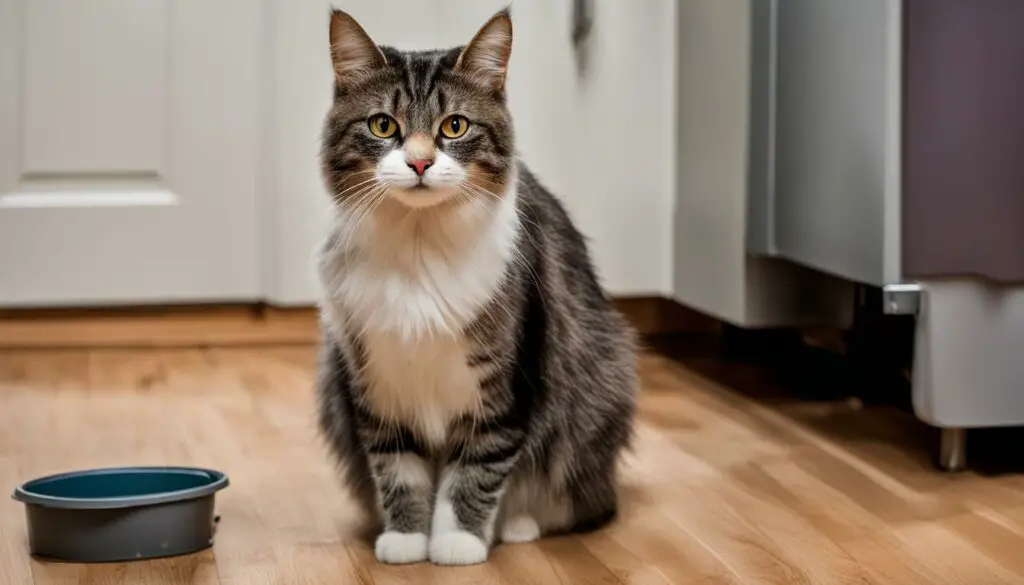
“As cats age, their mobility can decline, and this can make it challenging for them to use a traditional litter box. By making simple adjustments, like providing a low-sided box and creating a calm environment, we can help our elderly feline friends maintain their litter box habits and overall well-being.”
Cleaning and Deterrent Techniques
In order to address the issue of a cat pooping outside the litter box, it is crucial to implement effective cleaning and deterrent techniques. Thoroughly cleaning any areas where the cat has had accidents is essential to prevent recurring incidents. The use of enzymatic cleaners is highly recommended, as they are specifically designed to eliminate the odor and chemical traces that may attract the cat back to the same spot. By completely removing these odors, the likelihood of future accidents in that area is greatly reduced.
Additionally, the use of deterrents can help discourage the cat from pooping outside the litter box. Aluminum foil can be placed in areas where the cat tends to go, as cats generally dislike the texture and sound it produces when stepped on. This simple method can make those areas less desirable for the cat to use as an alternative to the litter box. There are also safe sprays available on the market that emit scents that cats find unpleasant, further deterring them from using certain areas as a bathroom.
While cleaning and deterrent techniques are important for preventing future accidents, it’s equally important to provide positive reinforcement when the cat uses the litter box correctly. Praising the cat, offering treats, or providing playtime after they have used the litter box can help reinforce the desired behavior and encourage them to continue using it consistently.
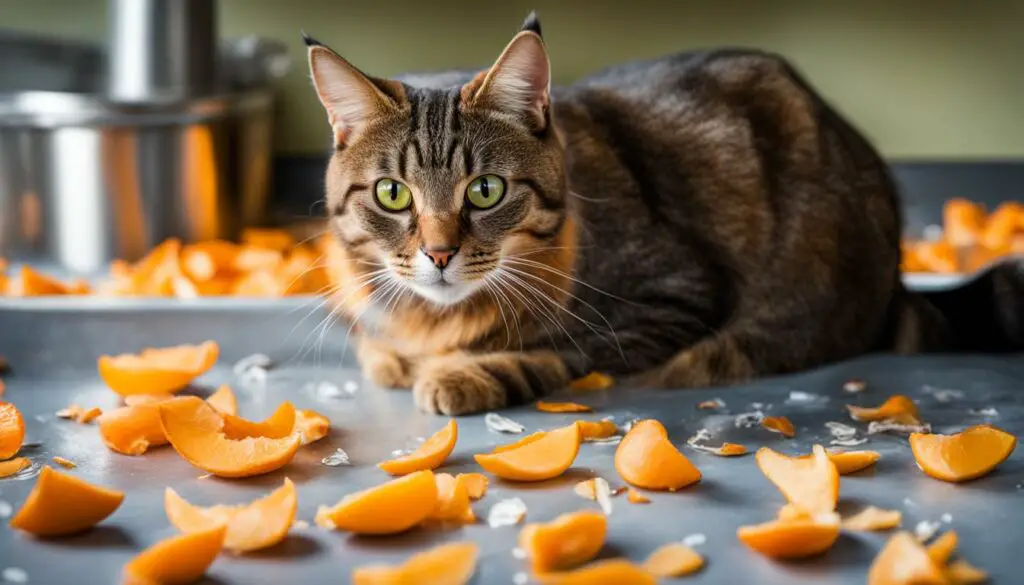
Table: Comparison of Cleaning and Deterrent Techniques
| Technique | Description |
|---|---|
| Enzymatic Cleaners | A specialized cleaning solution designed to eliminate odors and traces of cat waste, reducing the likelihood of repeat accidents. |
| Aluminum Foil | Placing aluminum foil in areas where the cat tends to go can deter them from using those spots as an alternative to the litter box due to the texture and sound it produces. |
| Safe Sprays | Using specially formulated sprays that emit scents cats find unpleasant can deter them from using certain areas as a bathroom. |
| Positive Reinforcement | Providing praise, treats, or playtime after the cat has used the litter box correctly can reinforce the desired behavior and encourage consistent usage. |
Consulting a Veterinarian
If your cat continues to poop outside the litter box despite your best efforts to resolve the issue, it is advisable to consult a veterinarian. A veterinarian can conduct a thorough examination of your cat to identify any underlying health issues that may be causing this behavior. They have the expertise to rule out medical conditions like constipation, arthritis, or urinary tract infections, which can make it difficult for your cat to use the litter box properly.
During the veterinary consultation, it is important to provide detailed information about your cat’s litter box habits, any changes in their environment, and their overall behavior. This information will help the veterinarian in diagnosing the cause of the litter box problem and recommending appropriate treatment or behavioral modifications.
Based on the vet’s recommendations, you may need to adjust your cat’s diet, administer medication, or make changes to the litter box setup or environment to address the issue. A veterinarian can provide valuable guidance and support in finding the best solutions for your cat’s specific needs, ensuring their health and well-being.

| Benefits of Consulting a Veterinarian |
|---|
| Accurate diagnosis of underlying health issues |
| Professional guidance on behavioral modifications |
| Potential medication or treatment options |
| Prevention of further complications or health issues |
| Ensuring the overall well-being of your cat |
Remember, a veterinarian is your ally in resolving litter box problems and improving your cat’s quality of life. Don’t hesitate to seek their professional advice and expertise.
Preventive Measures
In order to prevent litter box issues and maintain a healthy litter box routine, there are several key steps that cat owners can take. By implementing these preventive measures, you can help ensure that your cat consistently uses the litter box and reduce the likelihood of accidents occurring.
Create a consistent routine
One of the most important aspects of preventing litter box issues is establishing a consistent routine for your cat. Cats thrive on routine and familiarity, so providing them with a predictable schedule can help reduce stress and encourage proper litter box usage. Feed your cat at the same time each day, clean the litter box regularly, and maintain a consistent playtime and exercise routine to establish a sense of stability for your feline friend.
Maintain a clean litter box
Regularly cleaning the litter box is essential to maintain a clean and inviting environment for your cat. Scoop the litter box at least once a day to remove any waste and clumps. Every few weeks, completely empty the litter box and scrub it with mild soap and water. Ensure that the litter box is dry before adding fresh litter. By providing a clean litter box, you are more likely to encourage your cat to use it consistently.
Provide appropriate litter box options for multiple cats
If you have multiple cats in your household, it is important to provide enough litter box options to avoid conflicts and promote harmony. The general rule of thumb is to have one more litter box than the number of cats in your home. This ensures that each cat has their own designated space and reduces the likelihood of territory disputes or litter box avoidance. Place the litter boxes in separate areas of your home to provide easy accessibility for all cats.
Address changes in the cat’s environment promptly
Cats can be sensitive to changes in their environment, which can lead to stress and litter box problems. It is important to address any changes promptly and provide extra support and attention to your cat during these transitions. Whether it’s a new family member, a change in routine, or a new pet, take the time to help your cat adjust and create a comforting environment. This can help prevent litter box issues from arising in response to stress.
| Preventive Measures | Description |
|---|---|
| Create a consistent routine | Establish a predictable schedule for feeding, cleaning the litter box, and playtime to reduce stress and promote proper litter box usage. |
| Maintain a clean litter box | Scoop the litter box daily and deep clean it regularly to provide a clean and inviting environment for your cat. |
| Provide appropriate litter box options for multiple cats | Ensure that each cat has their own designated litter box and place them in separate areas of your home. |
| Address changes in the cat’s environment promptly | Help your cat adjust to any changes in their environment and provide extra support and attention during transitions. |
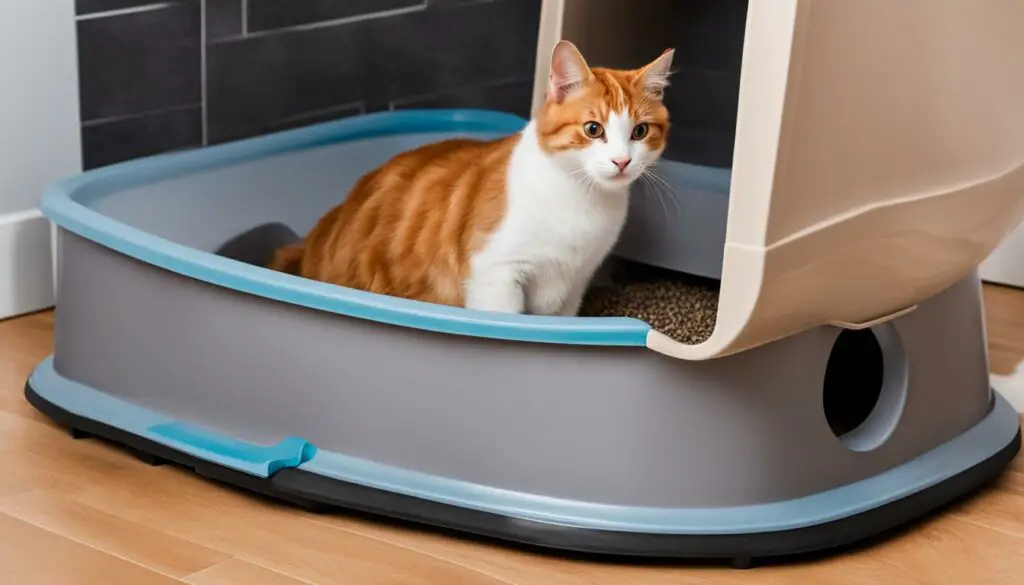
Understanding Cat Behavior
As cat owners, it’s important to understand the behavior of our feline companions to address any issues they may be facing. One common behavior that can cause frustration is territorial marking. Territorial marking is a way for cats to communicate and establish their territory. It can occur when there are changes in the household or the introduction of new pets. By understanding this behavior, we can take steps to reduce stress and prevent marking behaviors.
When a cat engages in territorial marking, they may spray urine or leave small amounts of feces in various areas of the home. This behavior is most commonly seen in unneutered males, but can also occur in neutered males and females. It’s important to note that cats do not engage in this behavior out of spite or to be disobedient. Instead, it is a natural instinct for them to mark their territory and communicate with other cats.
To reduce territorial marking, providing extra attention and environmental enrichment can be helpful. Spending quality time with your cat, providing interactive toys or scratching posts, and creating a comfortable and safe environment can help alleviate stress. Additionally, using pheromone sprays, which mimic the natural pheromones that cats use to mark their territory, can help provide a sense of security and reduce the likelihood of marking behaviors.
Understanding cat behavior, such as territorial marking, is key to addressing and preventing litter box problems. By creating a calming environment and providing appropriate outlets for their natural instincts, we can help our cats feel secure and reduce the likelihood of marking behaviors. Remember, if you have concerns about your cat’s behavior or litter box habits, it’s always best to consult with a veterinarian for guidance tailored to your cat’s specific needs.
The Importance of Environmental Enrichment
Environmental enrichment plays a crucial role in addressing and preventing territorial marking behaviors in cats. By providing a stimulating and enriching environment, we can help alleviate stress and reduce the likelihood of marking behaviors. Here are a few tips for creating a cat-friendly environment:
- Provide vertical spaces such as cat trees or shelves for climbing and perching.
- Offer a variety of toys to keep your cat mentally and physically stimulated.
- Set up hiding spots or cozy areas where your cat can retreat to when they need some quiet time.
- Ensure each cat has their own food and water bowls to prevent competition.
- Rotate toys and provide new ones periodically to keep your cat engaged and prevent boredom.
By implementing these environmental enrichment strategies, you can help create a positive and stimulating environment for your cat, reducing stress and promoting overall well-being.
| Common Cat Behaviors | |
|---|---|
| Behavior | Description |
| Territorial Marking | Leaving small amounts of feces or spraying urine to mark territory. |
| Scent Marking | Rubbing their face or body against objects to leave their scent. |
| Scratching | Using their claws to mark territory and stretch their muscles. |
| Kneading | Pushing their paws in and out against a soft surface. |
Understanding these common cat behaviors can help us better understand and communicate with our feline friends. By providing a stimulating environment, addressing their natural instincts, and seeking professional guidance when needed, we can ensure that our cats thrive both physically and emotionally.
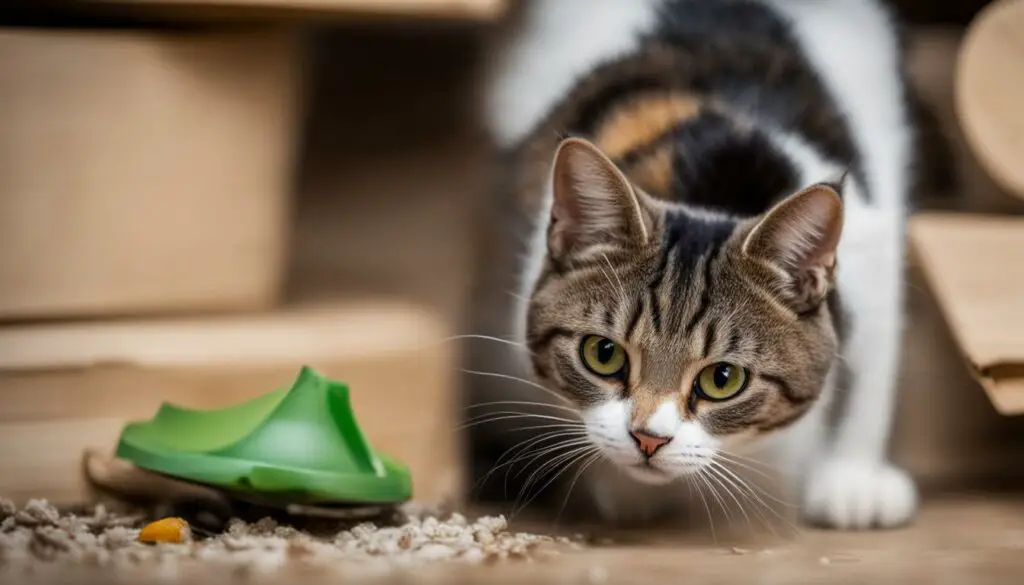
Conclusion
Resolving litter box problems can be a frustrating experience for cat owners, but understanding the underlying reasons and taking appropriate measures can help address the issue effectively. By troubleshooting the problem, cat owners can create a more comfortable and inviting environment for their feline friends.
First and foremost, it is essential to rule out any underlying health issues by consulting a veterinarian. Medical conditions and discomfort can cause cats to avoid the litter box, and appropriate treatment may be necessary.
In addition to addressing health problems, it is crucial to consider behavioral factors and environmental stressors. Cats are sensitive creatures, and changes in their routine or environment can lead to litter box issues. By identifying and minimizing stressors, cat owners can help their furry companions feel more secure and confident in using the litter box.
Maintaining a clean and well-suited litter box is another key aspect of resolving litter box problems. Regular cleaning, providing the right litter type, and ensuring accessibility are all essential factors. Creating a positive and consistent litter box routine can encourage proper bathroom habits.
Remember, if the issue persists despite your efforts, it is advisable to consult a veterinarian for further guidance. They can provide additional recommendations and support to help you find the best solutions for your cat’s specific needs.
FAQ
Why is my cat pooping outside the litter box?
Cats may poop outside the litter box due to various reasons such as health problems, stress, a smelly litter box, improper litter box placement, changes in the household, or new family members.
What are some possible health issues that can cause a cat to poop outside the litter box?
Cats may poop outside the litter box due to medical conditions such as constipation, arthritis, diarrhea, urinary tract infections, or gastrointestinal issues. These conditions can cause discomfort or make it difficult for the cat to use the litter box properly.
What are some behavioral factors that can contribute to a cat pooping outside the litter box?
Cats are sensitive creatures and changes in their environment or routine can cause stress, leading to litter box problems. Common behavioral factors include relocation, introduction of new pets, loud noises, changes in litter box cleanliness, or boredom.
How can I address litter box issues to encourage my cat to use it properly?
Cats can be picky when it comes to their litter box. A dirty litter box, improper location, small size, or unpleasant litter can deter a cat from using it. Keeping the litter box clean regularly, providing a quiet and private location, using a larger box, and using a litter type that the cat prefers can help encourage proper litter box usage.
How should I clean and maintain the litter box?
Regularly scooping clumps from the litter box, deep cleaning the box, and using unscented litter can help maintain a clean and inviting litter box. Using gloves and a face mask during the cleaning process is recommended for hygiene purposes. Enzymatic cleaners should be used to thoroughly clean any areas where the cat has pooped outside the litter box.
How many litter boxes should I have and where should I place them?
In multi-cat households, it is crucial to provide enough litter boxes to avoid conflicts and ensure each cat has its own space. The general rule is to have one more litter box than the number of cats in the house. Litter boxes should be placed in quiet and easily accessible areas, away from the cat’s food and sleeping areas.
What type of litter should I use for my cat?
Cats may have preferences when it comes to litter texture and scent. Some cats may prefer clumping clay litter, while others may prefer wheat-based or wood-based litter. It is essential to observe the cat’s preferences and avoid frequent changes in litter type to prevent aversion.
How can I reduce stress for my cat and create a comforting environment?
Creating a stress-free and comforting environment for the cat can help alleviate litter box problems. Maintaining a consistent routine, providing hiding spots or safe spaces, using pheromone sprays, and introducing interactive toys or scratching posts can help reduce stress and anxiety in cats.
How can I accommodate the litter box needs of an elderly cat?
Elderly cats may experience joint pain, arthritis, or mobility issues, making it difficult for them to use a standard litter box. Providing a low-sided box, ramps, or placing the litter box on a non-skid mat can help accommodate their needs.
How can I prevent recurring accidents and clean up properly?
Thoroughly cleaning any areas where the cat has pooped outside the litter box with enzymatic cleaners is crucial to prevent recurring accidents. Using deterrents like aluminum foil or safe sprays in areas where the cat tends to go can make those areas less desirable. Positive reinforcement should be provided when the cat uses the litter box correctly.
When should I consult a veterinarian regarding my cat’s litter box problems?
If the cat continues to poop outside the litter box despite efforts to resolve the issue, it is advisable to consult a veterinarian. They can conduct a thorough examination, identify any underlying health issues, and provide appropriate treatment or behavioral recommendations.
What preventive measures can I take to avoid future litter box problems?
Regular wellness checks for cats, maintaining a clean litter box, providing appropriate litter box options for multiple cats, and addressing any changes in the cat’s environment promptly can help prevent litter box problems. Ensuring the cat’s overall health and well-being is essential in preventing future accidents.
Why do some cats engage in territorial marking behaviors?
Cats may engage in territorial marking behaviors as a way to communicate and establish their territory. Introducing new pets or changes in the household can trigger territorial marking. Providing extra attention and environmental enrichment can help alleviate stress and reduce the likelihood of marking behaviors.
How can I understand my cat’s behavior better?
Understanding the reasons behind a cat pooping outside the litter box and taking appropriate measures, such as addressing health issues, maintaining a clean litter box, reducing stress, and providing a suitable environment, can help resolve litter box problems. It is important to consult a veterinarian for guidance and support in finding the best solutions for the cat’s specific needs.
Source Links
- https://kahootsfeedandpet.com/blogs/resource-center/h1-b-why-does-my-cat-potty-outside-of-the-litter-box-5-causes-and-how-to-fix-them-b-h1-p-p
- https://www.greatpetcare.com/cat-behavior/cat-pooping-outside-the-litter-box-8-tips-to-stop-it/
- https://www.thesprucepets.com/cat-pooping-outside-box-554017

